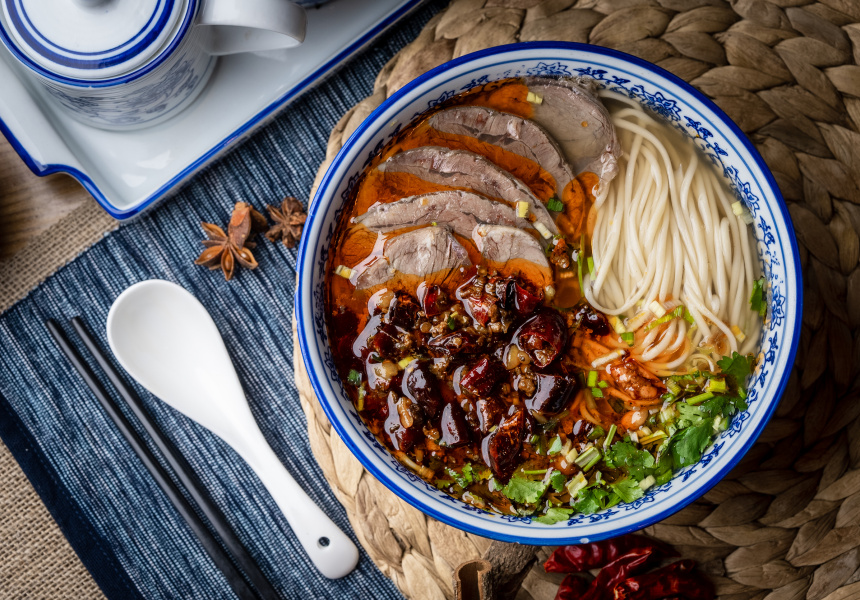When I was growing up, Sunday was Chinese day. It was the early ’90s. My parents were busy starting a business, and treating us kids to dinner at the local restaurant was their way of getting the family together regularly.
We’d sit around an oversized round table, drinking tea from dainty cups and gleefully spinning the lazy Suzy to pass each other prawn toast, fried rice and sweet and sour pork. At the end of the meal, my dad would give the shameful Messy Prize to whichever kid had spilled the most rice and plum sauce on the crisp white tablecloth.
That was Chinese food to us, and probably most non-Chinese Australians. We didn’t know we were eating Cantonese dishes from only a specific part of China – the legacy of thousands upon thousands of southern Chinese people arriving here in the second half of the 1800s.
We think you might like Access. For $12 a month, join our membership program to stay in the know.
SIGN UPBut at the end of the decade, that simple picture of Chinese cuisine started to get a lot more detailed. As successive governments defunded universities and left them to seek other revenue streams, the initial influx of Chinese and ethnically Chinese international students, which began in the 1950s, grew dramatically.
And near those universities, students and their relatives began opening restaurants replicating the tastes of home: spicy Chongqing hotpot, Shandong mackerel dumplings, Shaanxi biang biang noodles and other specialities from the vast, kaleidoscopic patchwork of cuisines we call Chinese.
Master Lanzhou is one of those restaurants. The chain of 11 fast-casual, order-at-the-counter noodle joints was founded in 2017 by Lu Gan, while she was studying economics at the University of Melbourne. And in the past year I’ve fallen deeply, madly in love with its specialty: hand-pulled wheat noodles, slow-cooked beef shin and crunchy daikon radish in a clear, consommé-like broth spiked with chilli oil.
The dish has Muslim roots and comes from the northern province of Gansu, where it snows lightly in winter. More specifically, it’s associated with the capital city of Lanzhou (say “lan-JO”, to rhyme with “dough”, not “zoo” or “how”). Across China it’s simply known as “Lanzhou hand-pulled noodle” (“Lanzhou lamian” in Mandarin).
This soup, this soup. Throughout this shitty winter, it’s carried me emotionally as much as physically. When I slurp the last of the complex, aromatic broth from the bowl, it’s like a gap opens in the grey clouds and a beam of divine light shines down to spiritually cleanse and uplift me. For 30 minutes after eating, all seems right in the world. When people talk about “soul” food, this is what they mean.
To this I say: chilli, it’s a hell of a drug.
At Master Lanzhou the menu is modular, with a choice of several broths and different noodle thicknesses. I like the spiciest broth, with a small island of dried chillies in the middle and enough house-made chilli oil to disperse a moderate protest on the steps of Parliament House. By the end of the meal my brows are moist, my lips are Sichuan-pepper numb, my pulse is up and my brain pleasantly fuzzed with dopamine and endorphins. For the chilli-averse, the standard #01 broth offers the same comfort, minus the endorphin rush.
For consistency, all of Master Lanzhou’s broths are simmered for three to four hours at a central kitchen in Dandenong, using up to 18 spices imported directly from northern China. The company has a person on the ground there, who haggles over different varieties, geographic origins, grades and seasons of Sichuan pepper (to pick one spice as an example). These kinds of distinctions don’t even exist in Australia, where Sichuan pepper is Sichuan pepper, and it’s likely to be stale, mediocre stock.
As with pho, Lanzhou lamian is often judged by the clarity of its broth. Using the right cut of beef is vital. Too much floating fat overpowers the earthy mix of spices, which typically includes star anise, cassia, ginger, cloves, cumin, fennel, liquorice root and black cardamom. And the beef should retain its texture and form, so brisket and its fall-apart friends are out.
Master Lanzhou only cooks with a lean, obscure cut called the conical muscle, itself a subsection of a cow’s shin/shank, sourced from Victorian Angus cows. Even after slow cooking it remains chewy and laced with tough cartilage. It’s not my first choice for eating, but I can’t deny it’s flavoursome and makes for transcendent broth.
The noodle dough, made from local flour, is mixed and portioned at each store before service, then pulled and boiled to order. You’ll feel this in the noodles’ springy yet silky texture. I like the wide belt-style noodle (kuan), which soaks up less broth than its spaghetti-like counterparts and takes the pressure off us slow and clumsy eaters.
If the previous few paragraphs didn’t make it clear as broth, this is a place where details matter – where the smallest, seemingly insignificant things are sweated over. And it makes all the difference. Though each bowl of noodles arrives just a few minutes after it’s ordered, the hours of preparation that go into each one justify Master Lanzhou’s tagline: “Slow food, served fast.”
“I Can’t Stop Thinking About” is a series about dishes Broadsheet’s editors are obsessed with.

